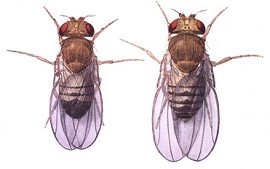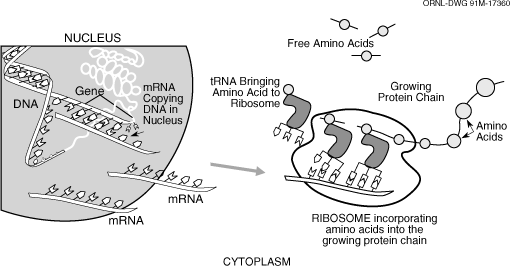|
Researchers are going to send fruit
flies to the International Space Station to learn what space travel
does to the genes of astronauts.
by Dr Tony Phillips
Fruit flies are bug
eyed and spindly, they love rotten bananas, and, following orders
from their pin-sized brains, they can lay hundreds of eggs every
day.
We have a lot in common.
Genetically speaking,
people and fruit flies are surprisingly alike, explains biologist
Sharmila Bhattacharya of NASA's Ames Research Centre."About 61%
of known human disease genes have a recognizable match in the genetic
code of fruit flies, and 50% of fly protein sequences have mammalian
analogues."
That's why fruit flies,
known to scientists as Drosophila melanogaster, are commonplace
in genetic research labs. They can be good substitutes for people.
They reproduce quickly, so that many generations can be studied
in a short time, and their genome has been completely mapped. "Drosophila
is being used as a genetic model for several human diseases including
Parkinson's and Huntington's," notes Bhattacharya.
They're about to become
genetic models for astronauts.

Side by side, a female and a male fruit fly.
|
Rice University professor
Kate Beckingham, working with Bhattacharya and Douglas Armstrong
at the University of Edinburgh, is planning to send some fruit flies
to the International Space Station (ISS). Their experiment is called
Drosophila Behaviour and Gene Expression in Microgravity. Its purpose
is to discover how space travel affects genes - both Drosophila
and human.
This is a matter of
much interest to NASA. During a typical space voyage, astronauts
are exposed to a range of gravitational forces. On a trip to Mars,
for instance, an explorer would feel several g's during
launch, 0-g during the long interplanetary cruise, several
more g's descending to Mars, and 0.38 g during
their stay on the red planet. How are genes going to react to these
changes? Will they express themselves in new or unexpected ways?
"Genes 'express themselves'
by commanding cells to make proteins," explains Beckingham. There
are about 50,000 different proteins in the human body, and they
do just about everything. They help us digest our food, clot blood
and heal wounds. They're the building blocks of cells and tissues.
"If genes command a different set of proteins in space, because
low-gravity tells them to, many of these things could change."

more
When genes are expressed, the genetic information on DNA
is first copied to a molecule of messenger RNA (mRNA)
. The mRNA carries that information from the cell nucleus
to the cytoplasm, where proteins are assembled from amino
acids.
|
"There's already evidence
that weightlessness alters genetic expression," she adds. In 1999,
for instance, scientists grew human kidney cells onboard the space
shuttle. More than one thousand of the cells' genes behaved differently.
Among other things, they produced extra vitamin D receptors. Surplus
vitamin D receptors can reduce the risk of prostate cancer in men.
Perhaps that's a benefit of space flight.
Other changes are less
positive. Studies have shown that disease-fighting cells in astronaut
immune systems don't attack germs as ferociously as they do on Earth.
If you get sick in space, it might be harder to get well again.
Astronauts bones weaken during long voyages, and without lots of
exercise, their muscles atrophy. "All of these things are rooted
in genetic expression," Beckingham says.
That space travel affects
genetic activity is uncontroversial. But researchers can't yet predict
which genes will be affected, or precisely how gravity signals a
gene to change its ways.
Hence the fruit fly.
Beckingham's team will breed as many as nine generations of Drosophila
onboard the ISS, with some 120 flies per generation. About 30 from
each batch will be collected by astronauts and frozen. Eventually
the frozen flies will be returned to Earth where researchers can
analyze their messenger RNA (mRNA), and thus their proteins, to
see which genes were more active or less active in orbit.
Onboard the ISS, "the
flies will be contained inside a special insect habitat," notes
Beckingham. Clear walls and a video camera allow the researchers
to monitor fly Behaviour"We'll be watching their courtship rituals,
their running speed, how they fly; these are clues to genetic activity."
The flies will also
spend some time spinning inside small centrifuges. "We can adjust
the spin to simulate different levels of gravity, ranging from near
weightlessness to twice the full gravity of Earth," says Beckingham.
"We might also explore Moon gravity (1/6 g) and Mars gravity"
to see how genetic expression might change on those worlds.

With fruit flies onboard, the ISS will become a genetics
research lab
|
Fruit flies will travel
to the ISS onboard the space shuttle after it returns to flight.
They'll begin their journey as eggs, hatch en route, and arrive
at the space station in larval form. Beckingham expects the baby
flies to grow and breed, producing the foundation of a swarm that
will orbit Earth for 90 days. That's not long for a human, but it
is many generations of fruit flies.
One day many generations
of people, too, will live in space. If genetic changes accumulate
from generation to generation - an unknown of space travel - settlers
on the Moon or Mars might diverge genetically from their Earth relatives.
Living on Mars really would turn you into a Martian. Fruit flies
could give us a preview of that process (if it exists).
"Nine generations of
Drosophila are not enough to draw strong conclusions about inherited
changes," cautions Bhattacharya. But it's a beginning. The 90-day
experiment will pinpoint some of the genes most affected by space
travel, and test the design of the habitat where more generations
of flies can live. Hundreds of generations would be needed to properly
study genetic evolution in space, believes Beckingham. "That's for
the future," she says.
Meanwhile, maybe, it's
time to start packing ISS supply rockets with bananas. Rotten, if
you please.
|
